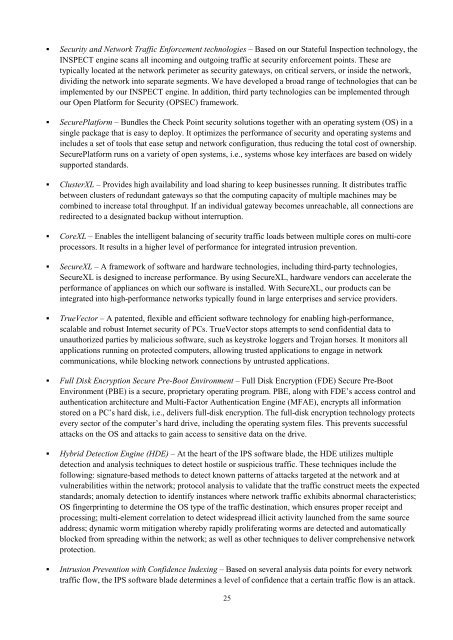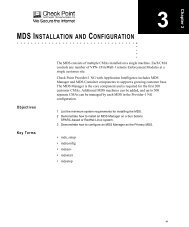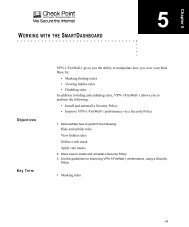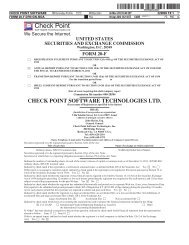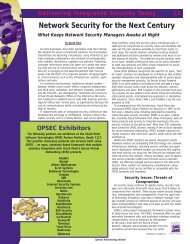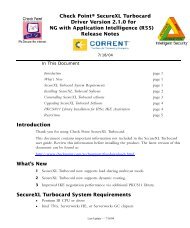FORM 20-F - Check Point
FORM 20-F - Check Point
FORM 20-F - Check Point
You also want an ePaper? Increase the reach of your titles
YUMPU automatically turns print PDFs into web optimized ePapers that Google loves.
� Security and Network Traffic Enforcement technologies – Based on our Stateful Inspection technology, the<br />
INSPECT engine scans all incoming and outgoing traffic at security enforcement points. These are<br />
typically located at the network perimeter as security gateways, on critical servers, or inside the network,<br />
dividing the network into separate segments. We have developed a broad range of technologies that can be<br />
implemented by our INSPECT engine. In addition, third party technologies can be implemented through<br />
our Open Platform for Security (OPSEC) framework.<br />
� SecurePlatform – Bundles the <strong>Check</strong> <strong>Point</strong> security solutions together with an operating system (OS) in a<br />
single package that is easy to deploy. It optimizes the performance of security and operating systems and<br />
includes a set of tools that ease setup and network configuration, thus reducing the total cost of ownership.<br />
SecurePlatform runs on a variety of open systems, i.e., systems whose key interfaces are based on widely<br />
supported standards.<br />
� ClusterXL – Provides high availability and load sharing to keep businesses running. It distributes traffic<br />
between clusters of redundant gateways so that the computing capacity of multiple machines may be<br />
combined to increase total throughput. If an individual gateway becomes unreachable, all connections are<br />
redirected to a designated backup without interruption.<br />
� CoreXL – Enables the intelligent balancing of security traffic loads between multiple cores on multi-core<br />
processors. It results in a higher level of performance for integrated intrusion prevention.<br />
� SecureXL – A framework of software and hardware technologies, including third-party technologies,<br />
SecureXL is designed to increase performance. By using SecureXL, hardware vendors can accelerate the<br />
performance of appliances on which our software is installed. With SecureXL, our products can be<br />
integrated into high-performance networks typically found in large enterprises and service providers.<br />
� TrueVector – A patented, flexible and efficient software technology for enabling high-performance,<br />
scalable and robust Internet security of PCs. TrueVector stops attempts to send confidential data to<br />
unauthorized parties by malicious software, such as keystroke loggers and Trojan horses. It monitors all<br />
applications running on protected computers, allowing trusted applications to engage in network<br />
communications, while blocking network connections by untrusted applications.<br />
� Full Disk Encryption Secure Pre-Boot Environment – Full Disk Encryption (FDE) Secure Pre-Boot<br />
Environment (PBE) is a secure, proprietary operating program. PBE, along with FDE’s access control and<br />
authentication architecture and Multi-Factor Authentication Engine (MFAE), encrypts all information<br />
stored on a PC’s hard disk, i.e., delivers full-disk encryption. The full-disk encryption technology protects<br />
every sector of the computer’s hard drive, including the operating system files. This prevents successful<br />
attacks on the OS and attacks to gain access to sensitive data on the drive.<br />
� Hybrid Detection Engine (HDE) – At the heart of the IPS software blade, the HDE utilizes multiple<br />
detection and analysis techniques to detect hostile or suspicious traffic. These techniques include the<br />
following: signature-based methods to detect known patterns of attacks targeted at the network and at<br />
vulnerabilities within the network; protocol analysis to validate that the traffic construct meets the expected<br />
standards; anomaly detection to identify instances where network traffic exhibits abnormal characteristics;<br />
OS fingerprinting to determine the OS type of the traffic destination, which ensures proper receipt and<br />
processing; multi-element correlation to detect widespread illicit activity launched from the same source<br />
address; dynamic worm mitigation whereby rapidly proliferating worms are detected and automatically<br />
blocked from spreading within the network; as well as other techniques to deliver comprehensive network<br />
protection.<br />
� Intrusion Prevention with Confidence Indexing – Based on several analysis data points for every network<br />
traffic flow, the IPS software blade determines a level of confidence that a certain traffic flow is an attack.<br />
25


